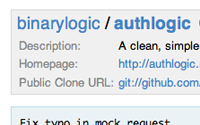#160 Authlogic
May 04, 2009 | 14 minutes | Plugins, Authentication
Authentication can get very complex. In this episode I show how Authlogic can handle this complexity while you stay in control of how it is presented to the user.
- Download:
- source codeProject Files in Zip (97.4 KB)
- mp4Full Size H.264 Video (22.8 MB)
- m4vSmaller H.264 Video (15.2 MB)
- webmFull Size VP8 Video (42.7 MB)
- ogvFull Size Theora Video (34.4 MB)
Resources
- Authlogic
- Authlogic Example/Tutorial
- Authlogic RDoc
- Episode 67: restful_authentication
- Nifty Generators
- Full Episode Source Code
Note: Don't forget to specify "password" in the filter_parameter_logging line in your ApplicationController. Otherwise the password will be stored as plain text in the log file.
bash
sudo rake gems:install script/generate nifty_scaffold user username:string email:string password:string new edit rake db:migrate script/generate session user_session script/generate nifty_scaffold user_session --skip-model username:string password:string new destroy
config/environment.rb
config.gem "authlogic"
models/user.rb
acts_as_authentic
users_controller.rb
def create @user = User.new(params[:user]) if @user.save flash[:notice] = "Registration successful." redirect_to root_url else render :action => 'new' end end def edit @user = current_user end def update @user = current_user if @user.update_attributes(params[:user]) flash[:notice] = "Successfully updated profile." redirect_to root_url else render :action => 'edit' end end
user_sessions_controller.rb
def create @user_session = UserSession.new(params[:user_session]) if @user_session.save flash[:notice] = "Successfully logged in." redirect_to root_url else render :action => 'new' end end def destroy @user_session = UserSession.find @user_session.destroy flash[:notice] = "Successfully logged out." redirect_to root_url end
application_controller.rb
filter_parameter_logging :password helper_method :current_user private def current_user_session return @current_user_session if defined?(@current_user_session) @current_user_session = UserSession.find end def current_user return @current_user if defined?(@current_user) @current_user = current_user_session && current_user_session.record end
config/routes.rb
map.login "login", :controller => "user_sessions", :action => "new" map.logout "logout", :controller => "user_sessions", :action => "destroy"
layouts/application.html.erb
<div id="user_nav"> <% if current_user %> <%= link_to "Edit Profile", edit_user_path(:current) %> | <%= link_to "Logout", logout_path %> <% else %> <%= link_to "Register", new_user_path %> | <%= link_to "Login", login_path %> <% end %> </div>
user_sessions/new.html.erb
<% title "Login" %> <% form_for @user_session do |f| %> <%= f.error_messages %> <p> <%= f.label :username %><br /> <%= f.text_field :username %> </p> <p> <%= f.label :password %><br /> <%= f.password_field :password %> </p> <p><%= f.submit "Submit" %></p> <% end %>
users/_form.html.erb
<% form_for @user do |f| %> <%= f.error_messages %> <p> <%= f.label :username %><br /> <%= f.text_field :username %> </p> <p> <%= f.label :email %><br /> <%= f.text_field :email %> </p> <p> <%= f.label :password %><br /> <%= f.password_field :password %> </p> <p> <%= f.label :password_confirmation %><br /> <%= f.password_field :password_confirmation %> </p> <p><%= f.submit "Submit" %></p> <% end %>
application.css
#user_nav { float: right; font-size: 12px; }


